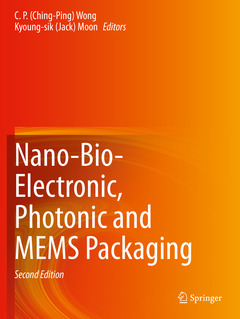Nano-Bio- Electronic, Photonic and MEMS Packaging (2nd Ed., 2nd ed. 2021)

This book shows how nanofabrication techniques and nanomaterials can be used to customize packaging for nano devices with applications to electronics, photonics, biological and biomedical research and products. It covers topics such as bio sensing electronics, bio device packaging, MEMS for bio devices and much more, including:
- Offers a comprehensive overview of nano and bio packaging and their materials based on their chemical and physical sciences and mechanical, electrical and material engineering perspectives;
- Discusses nano materials as power energy sources, computational analyses of nano materials including molecular dynamic (MD) simulations and DFT calculations;
- Analyzes nanotubes, superhydrophobic self-clean Lotus surfaces;
- Covers nano chemistry for bio sensor/bio material device packaging.
This second edition includes new chapters on soft materials-enabled packaging for stretchable and wearable electronics, stateof the art miniaturization for active implantable medical devices, recent LED packaging and progress, nanomaterials for recent energy storage devices such as lithium ion batteries and supercapacitors and their packaging.
Nano- Bio- Electronic, Photonic and MEMS Packaging is the ideal book for all biomedical engineers, industrial electronics packaging engineers, and those engaged in bio nanotechnology applications research.
C. P. Wong is the Charles Smithgall Institute Endowed Chair and Regents’ Professor at Georgia Institute of Technology and a member of the National Academy of Engineering of the USA since 2000, and a foreign academician of the Chinese Academy of Engineering since 2013. After his doctoral study at Pennsylvania State University, he was awarded a two-year postdoctoral fellowship with Nobel Laureate Professor Henry Taube at Stanford University. Prior to joining Georgia Tech, he was with AT&T Bell Laboratories for many years and became an AT&T Bell Laboratories Fellow in 1992. His research interests lie in the fields of polymeric materials, electronic packaging and interconnect, interfacial adhesions, energy storage devices, nano-functional material syntheses and characterizations. nano-composites such as well-aligned carbon nanotubes, graphenes, lead-free alloys, flip chip underfill, ultra-high k capacitor composites and novel lotus effect coating materials.
Kyoung-sik (Jack) Moon is Research Faculty with the School of Materials Science and Engineering at George Tech. He received the B.S., M.S. and Ph.D. degrees in materials science and engineering from Korea University, Seoul, Korea, in 1995, 1997 and 1999, respectively. He has published over 135 journal and 140 proceedings papers as author and co-author. His research interests lie in the materials for electrical and thermal interconnections and chemical, physical and electromagnetic protections of IC devices in microelectronics and photonics packaging, and energy storage devices.
Yi Li is Engineering TD manager at Intel Corp. Chandler, AZ, USA. She received the B.S. and M.S. degrees in materials science and engineering from Zhejiang University, Hangzhou, China, in 2000 and 2002, respectively, and the Ph.D. degree in materials science and engineering from the Georgia Institute of Technology, Atlanta, in 2007. She is the author of four book chapters and authored and c
Date de parution : 03-2022
Ouvrage de 582 p.
21x27.9 cm
Date de parution : 03-2021
Ouvrage de 582 p.
21x27.9 cm


